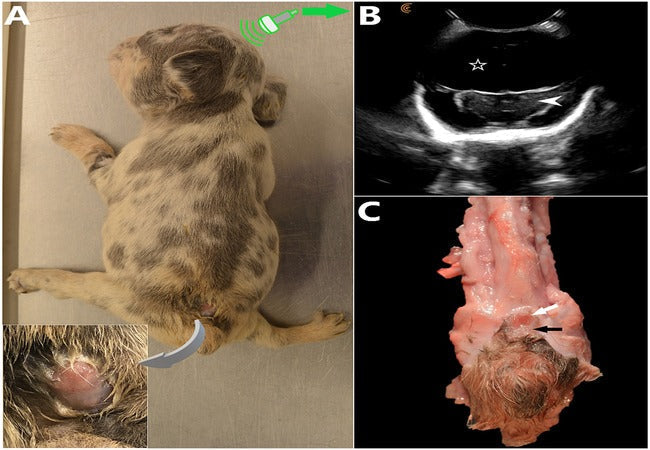Vet’s 2025 Guide to Canine Spinal Dysraphism (Myelodysplasia) – Neural Tube Defects & Tethered Cord🩺

In this article
Canine Spinal Dysraphism (Myelodysplasia) – Neural Tube Defects & Tethered Cord🩺
By Dr. Duncan Houston BVSc
💡 What Is Spinal Dysraphism?
Spinal dysraphism, also known as myelodysplasia or neural tube defect, refers to congenital malformations due to incomplete closure of the neural tube, resulting in spinal canal and spinal cord defects. It encompasses a spectrum from spina bifida occulta and meningoceles to lipomyelomeningoceles, tethered cord, split‑cord malformations, and diplomyelia.
🚩 Who Is Affected?
- 🐾 Most cases are present at birth; signs emerge around 4–6 weeks as puppies begin walking.
- 👶 Affected breeds include Weimaraners (genetically tested via NKX2‑8 gene), English/French Bulldogs, Collies, and various mixes.
- 🔬 Weimaraner-specific mutation is autosomal recessive—homozygous (SD/SD) dogs are affected; carriers (N/SD) are normal.
👀 Clinical Signs & Presentation
- 🐇 “Bunny‑hopping” gait—hind limbs move simultaneously, wide-based crouch gait.
- 🦵 Pelvic limb weakness, ataxia, reduced reflexes; front limbs are typically normal.
- 🚻 Can include urinary and fecal incontinence if L4–S3 segments are involved.
- 🛑 The condition is non-progressive—signs appear early and remain stable.
🧪 Diagnostic Approach
- History and exam: onset at walking age, characteristic gait, neurological evaluation (proprioception, reflexes).
- Genetic testing: Weimaraner NKX2‑8 mutation screening to identify carriers or affected pups.
-
Advanced imaging:
- CT myelography: detects vertebral and canal bony defects—e.g., missing arch, diplomyelia, spina bifida.
- MRI: ideal for identifying soft tissue herniations—meningoceles, lipomyelomeningocele, tethered cord and split cords.
- Additional tests: cutaneous indicators (hair tuft, dermal sinus), orthopedic/neurologic labs to rule out other issues.
⚙️ Treatment & Management
1. Surgical Intervention
- 🔧 Decompression & resection: for meningoceles, lipomyelomeningoceles, split cord malformations—can restore function; one case resolved incontinence and paresis post-laminectomy.
- 🧠 Tethered cord release: untethering prevents ongoing neural traction—used in humans and dogs but less common.
2. Supportive Care & Rehabilitation
- 🏥 Physical therapy—hydrotherapy and assisted exercises enhance muscle tone and coordination.
- 🦽 Mobility aids—harnesses, slings, rugs to assist posture and prevent slipping.
- 🩺 Bladder/bowel management—expression, diapers, skin care to prevent infection and scalding.
- 💊 Analgesics and NSAIDs as needed for discomfort or spinal pain.
3. Breeder & Genetic Counseling
- 🧬 Affected or carrier dogs should be removed from breeding pools, especially in Weimaraners where genetic testing is available.
- 📋 Pedigree evaluation helps avoid passing the trait to offspring.
📈 Prognosis & Life Outlook
- 🟢 Most dogs live full, normal lives—condition is non-progressive.
- 🟡 Those with incontinence or paresis may regain partial or full function post-surgery; early treatment improves outcome.
- 🔴 Severe malformations or complications may require long-term management or euthanasia if mobility and quality diminish significantly.
🏡 Ask A Vet App: Home‑Support Tools 📲🐶
- 📆 Schedule rehabilitation and bladder expression reminders.
- 📊 Track gait, hind limb strength, continence, and reflex changes.
- 📸 Upload videos showing gait and posture for remote vet review.
- 🔔 Set alerts for sudden gait decline, incontinence, or signs of pain.
- 📚 Use in-app guides: home physiotherapy, bladder care, harness use.
🔑 Key Takeaways 🧠✅
- Spinal dysraphism stems from neural tube closure failure—includes lipomeningoceles, split cords, tethered cord.
- Puppies present with classic bunny‑hop gait, hind limb weakness, and sometimes incontinence.
- Confirm diagnosis via CT or MRI; genetic testing in Weimaraners identifies carriers.
- Surgery offers a cure in some cases—post-op improvement is common.
- Supportive rehab helps maintain mobility; bladder care prevents complications.
- Breeding prevention essential; Ask A Vet enhances home monitoring and vet-owner collaboration.
🩺 Final Thoughts ❤️
In 2025, managing spinal dysraphism means early identification and tailored intervention. Surgery can resolve many defects, and when combined with robust home care—bladder management, rehab, digital monitoring—most dogs lead fulfilling lives. As always, proactive genetic screening, early vet involvement, and leveraging tools like the Ask A Vet app position families for the best possible outcomes. 🐾✨
Visit AskAVet.com and download the Ask A Vet app to log gait progress, upload videos, set care reminders, track bladder routines, and stay connected with veterinarians anytime. 📲🐶






